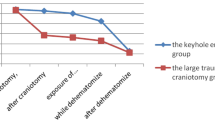Summary
The authors have studied the indications and limitations for computerized tomography (CT) -guided stereotaxic surgery (CTGS Surgery) of hypertensive intracerebral haematomas (ICH), based on the analysis of 158 patients in our institutions. Of 158 patients, 120 had putaminal haemorrhage, 21 thalamic, 14 subcortical and 3 in other locations. The patients ranged in age from 37 to 82 years (average 60). Haematoma volume ranged from 8 to 140 ml (average 43).
Eleven patients in the series worsened postoperatively because of rebleeding in 6 cases, cerebral infarction in 2, and unknown causes in the remaining 3 cases. Seven of the 11 patients pre-operatively had untreated hypertension and 3 had mild liver dysfunction without major haemorrhagic tendency. Most postoperative complications were seen in older patients and in those with severe neurological deficit or chronic disease. All these cases ended in poor outcome.
From our study, we propose three indications for CTGS Surgery: absolute, aggressive and passive indications. The absolute indication is applied to those who would have been operated on by conventional open surgery. The aggressive indication is for those with mild neurological deficit so that early rehabilitation can be started to regain higher cerebral function. The passive indication is for elderly patients and those with severe neurological deficit or chronic disease. This indication must be decided carefully because poor outcome is likely.
Similar content being viewed by others
References
Backlund EO (1978) Controlled subtotal evacuation of intracerebral haematoma by stereotactic technique. Surg Neurol 9: 99–101
Doi E (1982) Stereotactic evacuation of intracerebral hematomas. Neuro Med Chir (Tokyo) 22: 461–467
Fujitsu K (1990) Indications for surgical treatment of putaminal hemorrhage. Comparative study based on serial CT and timecourse analysis. J Neurosurg 73: 518–525
Hondo H (1987) Clinical evaluation of aspiration surgery for acute hypertensive putaminal hemorrhage on the cases of neurological grading 3 and 4 a. In: Proceeding of the 2nd Workshop of Hypertensive Intracerebral Hemorrhage, Vol 2. Neuron, Tokyo, pp 39–45
Juvela S (1989) The treatment of spontaneous intracerebral hemorrhage. A prospective randomized trial of surgical and conservative treatment. J Neurosurg 70: 755–758
Kanaya H (1978) A neurological grading for patients with hypertensive intracerebral hemorrhage and a classification for hematoma location on computed tomography. In: Proceeding of the 7th Conference on Surgical Treatment of Stroke. Neuron, Tokyo, pp 265–270
Kanaya H (1980) Grading and indication for treatment of ICH of basal ganglia (cooperative study in Japan). In: Pia HW, Langmaid C, Zierski J (eds) Spontaneous intracerebral haematomas. Advances in diagnosis and therapy. Springer, Berlin Heidelberg New York, pp 268–274
Kandel IK (1985) Stereotaxic evacuation of spontaneous intracerebral hematomas. J Neurosurg 62: 206–213
Kaneko M (1983) Long-term evaluation of ultra-early operation for hypertensive intracerebral hemorrhage in 100 cases. J Neurosurg 58: 838–842
Kanno T (1986) Evacuation of the hypertensive intracerebral hematoma based on the study of long-term outcome, Part 2. A role of surgery in putaminal hemorrhage. No Shinkei Geka (Tokyo) 14: 1307–1311
Komai N (1986) Stereotactic evacuation using plasminogen activator (urokinase) for hypertensive putaminal hemorrhage. In: Proceeding of the 1st Workshop of Hypertensive Intracerebral Hemorrhage. Neuron, Tokyo, pp 55–62
Kuroda K (1982) Regional cerebral blood flow in patients with hypertensive intracerebral hemorrhage-patients with putaminal hemorrhage treated surgically. Brain Nerve (Tokyo) 34: 561–569
Matsumoto K (1984) CT-guided stereotaxic evacuation of hypertensive intracerebral hematomas. J Neurosurg 61: 440–448
McKissock W (1959) Primary intracerebral haemorrhage. Results of surgical treatment in 244 consecutive cases. Lancet II: 683–686
Niizuma H (1986) CT-guided stereotaxic aspiration in 70 cases of hypertensive putaminal hemorrhage. In: Proceeding of the 1st Workshop of Hypertensive Intracerebral Hemorrhage. Neuron, Tokyo, pp 80–85
Nishiya M (1986) The effects of CT-guided stereotactic aspiration on putaminal hemorrhage (hematoma volume 15–40 ml). In: Proceeding of the 1st Workshop of Hypertensive Intracerebral Hemorrhage. Neuron, Tokyo, pp 73–79
Sawada T (1983) Comparison of medial and surgical treatments of hypertensive intracerebral hemorrhage. In: Mizukami M, Kanaya H, Kogure Ket al (eds) Hypertensive intracerebral hemorrhage. Raven, New York, pp 233–238
Shichijo F (1985) CT-controlled stereotactic operation for hypertensive intracerebral hemorrhage. Part 2: cases with small hematomas in the thalamus and the basal ganglia. No Shinkei Geka (Tokyo) 13: 945–952
Tanizaki Y (1985) New CT-guided stereotactic apparatus and clinical experience with intracerebral hematomas. In: Tasker RR, Turnbull IM, Gildenberg Phl, Franklin PO (eds) Proc 9th Meeting World Soc Stereotactic and Functional Neurosurgery, Toronto 1985. Appl Neurophysiol: 11–17
Tanizaki Y (1988) Improvement of cerebral blood flow following stereotactic surgery in patients with putaminal haemorrhage. Acta Neurosurg 90: 103–110
Teasdale G (1976) Assessment and prognosis of coma after head injury. Acta Neurochir (Wien) 34: 45–55
Waga S (1983) Hypertensive putaminal hemorrhage: treatment and results. Is surgical treatment superior to conservative one? Stroke 14: 480–485
Waga S (1986) Hypertensive putaminal hemorrhage: analysis of 182 patients. Surg Neurol 26: 159–166
Author information
Authors and Affiliations
Rights and permissions
About this article
Cite this article
Hokama, M., Tanizaki, Y., Mastuo, K. et al. Indications and limitations for CT-guided stereotaxic surgery of hypertensive intracerebral haemorrhage, based on the analysis of postoperative complications and poor ability of daily living in 158 cases. Acta neurochir 125, 27–33 (1993). https://doi.org/10.1007/BF01401824
Issue Date:
DOI: https://doi.org/10.1007/BF01401824




